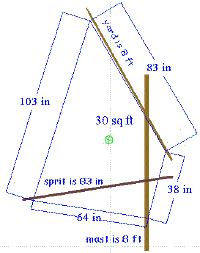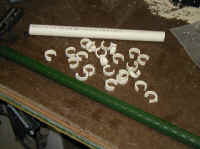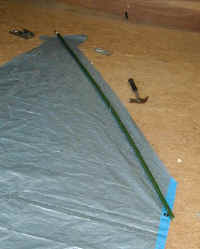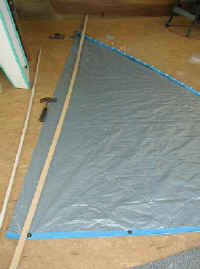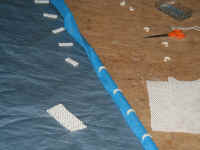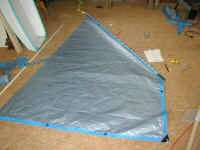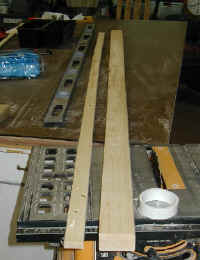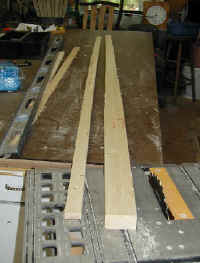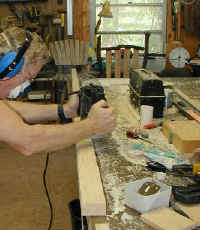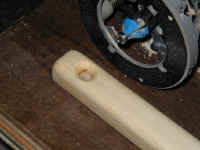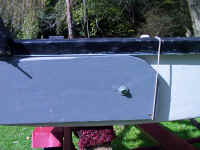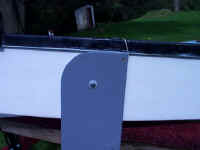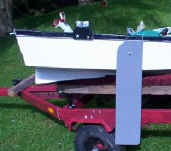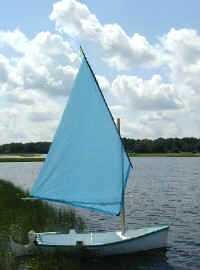 |
Simplicity Sail rig ...no tape, no stitching, no glue! Mini-Sharpie lug rig |
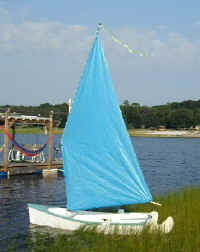 |
This sail making approach was inspired by the impressive way my experimental crab claw rig has held up. This is partly instructions on how to make a sail for the Mini-Sharpie, and also a report on an approach to sail making. At first I did this to refine a sail design before I made one of "the good stuff" (White heavy duty Poly from Dave's sail making site) but it might be a viable way to make small sails in any case. Time will tell.
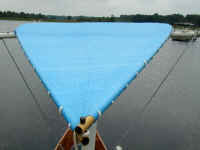 |
The original crab claw sail has been left rigged and under tension in the Florida summer sun for over 3 months. The polytarp is breaking down, but the clips are still in great shape and have held the tension to the spars extremely well. | 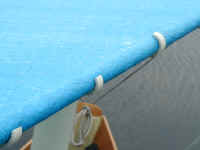 |
I decided to use this same clip approach to make a more traditional sail, but with very un-traditional materials and fasteners. I figure the easier it is to alter the size and shape of a sail the more apt I would be to keep experimenting until I arrive at the best arrangement.
Here are build notes for a standing lug sail that can be assembled in two or three hours, including the mast and spars - if you work fast. (A balanced lug can be made by using the sprit as a boom, and attaching it to the foot of the sail with clips too.)
One fairly clear spruce 2x4 can yield spars (see spar making below) , an 8x10 poly tarp the sail cloth, a short length of appropriately sized PVC pipe for the clip fasteners.
 |
Here are some samples of how different sized sticks fit into 1" PVC clips. |
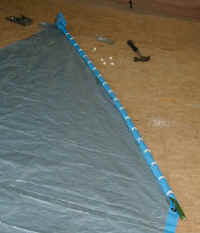 |
.I wrap and clip the polytarp around the spar. I also used some small nylon cable ties to secure the ends. |
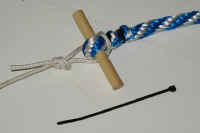 |
Now for some rigging details....
This is a wooden toggle method of attaching lines - like the halyard and the main sheet - to the yard and the sprit boom. Instead of getting out a needle and sail twine and palm and doing fancy "seizing" of the line to a 3/8" dowel, I'm using small nylon cable ties. |
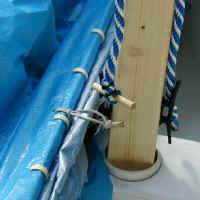 |
Here it is rigged for use. A loop of 1/8" polyester line (could be nylon but it stretches more) is attached around the yard through a hole. This hole can be either melted with a soldering iron or the tip of a hot melt glue gun, or simply made with an awl or a nail. |
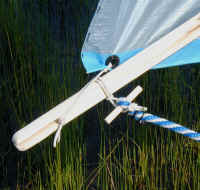 |
Here's the same arrangement where the main sheet connects to the sprit boom. |
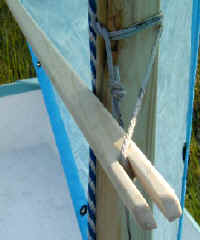 |
Here are some close ups of the sprit rigging at the mast
The line (called the "snotter") that attaches it to the mast - starts with an overhand loop in the end, which will function as a block or pulley. A constrictor hitch is tied around the mast - the long part goes through the slot in the end of the sprit then back through the loop and down to a mast cleat. (Click knot name link to see an animation of the knot.) This masterly animated constrictor hitch was fiendishly borrowed from Craig O'Donnell's Cheap Pages.... which contains more fascinating boat info and esoterica than one could absorb in a lifetime! Go Browse his site.... |
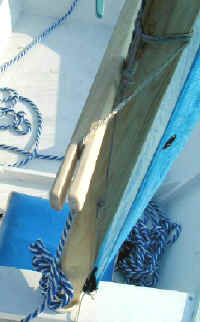 |
Rather than just cleat it off, I run it through the hollow
at the base of a cleat and then back up where I tie a taut
line hitch around the standing part. This way you don't need an
extra cleat, and sliding the taught line hitch up and down controls the
sprit tension. Looser for light air and tighter for stronger air.
(Click knot link to see an animation of the knot.)
|
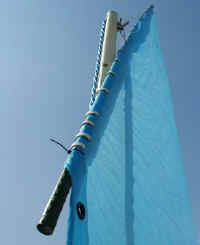 |
.Here's the yard hoisted. (I trimmed that cable tie later.) |
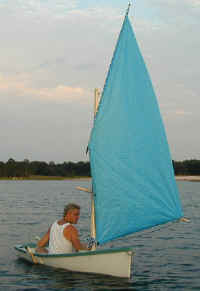 |
Here's a shot under sail. You see how my 180 lbs is close to her limits as a sailing craft. Though my 40 lb dog swam out to me and I yanked her aboard in front of the mast and I think she helped a bit with trim....;-) |
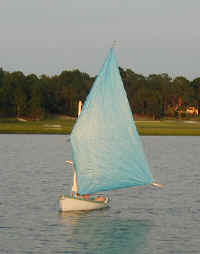 |
The sail functioned very well, but I decided that it was a
little difficult to see well under it, and that it might be a little more
sail area than younger kids might easily handle in any kind of
breeze...
So I decided to go back to the "loft floor" and make her a bit smaller. |
| .Now to test this quick and easy sail making approach on this alteration. | |
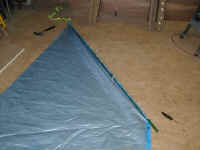 |
How long will it take to reduce the sail area? Every step of making the first sail will be repeated, except I wont be cutting the curved leach. |
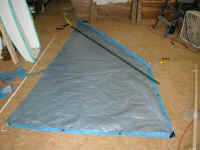 |
First I clipped off the cable ties and removed the clips. Then I tacked down the sail corners and set the yard in the new position. |
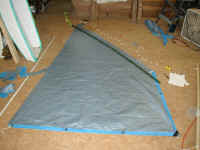 |
.Again with three nails I sprung a bow in the yard and trimmed the sail material 4.5" outside the spar edge. |
Back to Methods and Materials
